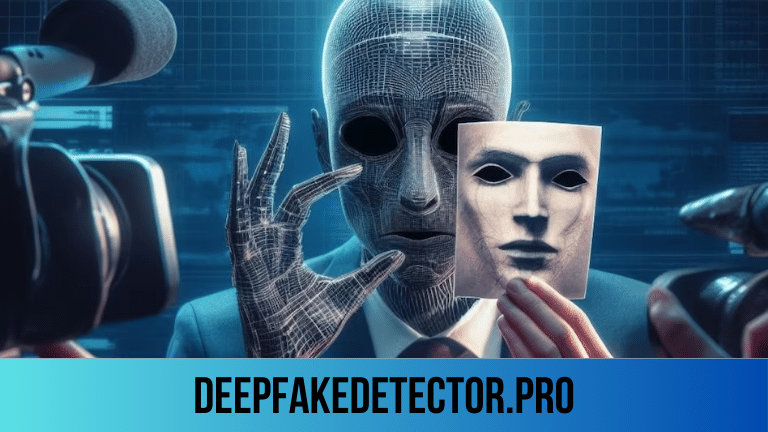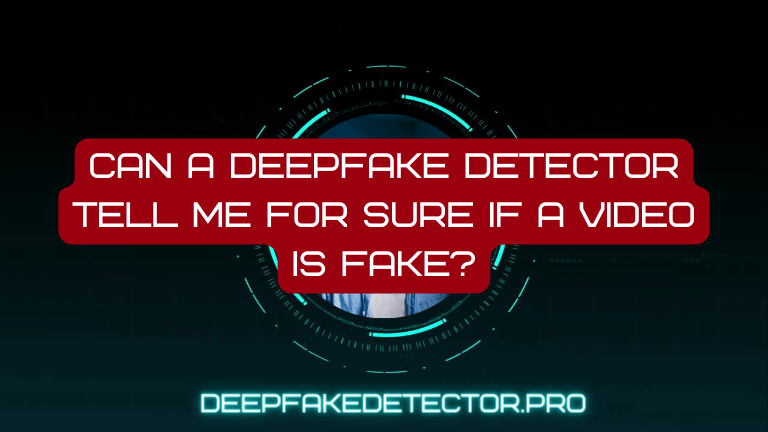Can a Deepfake Detector Tell Me for Sure if a Video is Fake? which are synthetic media generated by artificial intelligence (AI) to swap, replace, or impersonate individuals’ faces and voices, have become increasingly sophisticated and difficult to detect with the naked eye. As these deceptive videos and images continue to circulate online, the demand for reliable deepfake detection tools has grown exponentially.
The development of deepfake detectors has emerged as a crucial line of defense against the spread of misinformation and the potential harm caused by these manipulated media. However, the question remains: Can a deepfake detector truly tell you with absolute certainty whether a video is fake or not?
In this comprehensive article, we will delve into the intricacies of deepfake detection techniques, exploring their strengths, limitations, and the ongoing battle between creators and detectors in the rapidly evolving landscape of synthetic media.
Understanding Deepfakes and Their Impact
Before diving into the world of deepfake detection, it’s essential to understand the nature of deepfakes and the potential risks they pose.
What are Deepfakes?
Deepfakes are a form of synthetic media created using advanced machine learning techniques, primarily deep learning algorithms. These algorithms are trained on massive datasets of images or videos, allowing them to learn and replicate the intricate details of human faces, expressions, and movements.
With deepfake technology, it is possible to create highly realistic videos that depict individuals saying or doing things they never actually said or did. This process involves swapping or superimposing one person’s face onto another person’s body or creating entirely new synthetic videos from scratch.
The Potential Dangers of Deepfakes
While deepfakes have legitimate applications in fields such as entertainment and creative industries, their malicious use raises significant concerns:
- Misinformation and Disinformation: Deepfakes can be used to create misleading or false narratives, potentially influencing public opinion, elections, or even inciting social unrest.
- Defamation and Harassment: Deepfake technology can be weaponized to create explicit or compromising videos of individuals without their consent, leading to defamation, harassment, and severe reputational damage.
- Financial Fraud: Deepfakes could be used to impersonate high-profile individuals or executives, potentially facilitating financial fraud or corporate espionage.
- Erosion of Trust: The widespread proliferation of deepfakes can undermine public trust in visual media, making it increasingly difficult to distinguish fact from fiction.
These concerns have fueled the urgency to develop reliable deepfake detection methods to combat the potential harms and restore trust in digital media.
Deepfake Detection Techniques
Researchers and technology companies have been working tirelessly to develop various deepfake detection techniques to identify synthetic media. These techniques employ a combination of traditional computer vision methods and advanced machine learning algorithms to analyze and identify the subtle anomalies and inconsistencies present in deepfake videos.
Biological Signal Analysis
One of the most promising deepfake detection techniques involves analyzing biological signals, such as eye movements, blinking patterns, and subtle facial muscle movements. These signals are often difficult for deepfake algorithms to replicate accurately, and their presence or absence can serve as indicators of manipulation.
Techniques like eye-tracking analysis, which examines the consistency of eye movements and pupil dilation, and facial landmark analysis, which monitors the natural movements of facial features like the mouth and eyebrows, have shown promising results in detecting deepfakes.
Pixel-Level Inconsistencies
Deepfake detectors can also analyze the pixel-level inconsistencies present in manipulated videos. These inconsistencies may include artifacts, blurring, or unnatural patterns that are difficult for deepfake algorithms to avoid, even with advanced techniques like generative adversarial networks (GANs).
Methods like error level analysis (ELA), which detects compression artifacts, and frequency analysis, which examines the frequency components of an image or video, can be effective in identifying pixel-level anomalies associated with deepfakes.
Temporal Inconsistencies
Deepfake videos often exhibit temporal inconsistencies, or irregularities in the way objects or individuals move over time. These inconsistencies can arise from imperfections in the deepfake algorithm or the process of stitching together multiple frames from different sources.
Techniques like motion analysis, which tracks the movement of objects and individuals across frames, and head pose estimation, which examines the orientation of the head and its consistency with natural movements, can help detect temporal irregularities indicative of deepfakes.
Machine Learning-Based Detection
With the rapid advancements in machine learning and deep learning, researchers have developed sophisticated models specifically designed to detect deepfakes. These models are trained on vast datasets of real and synthetic media, learning to recognize the subtle patterns and artifacts associated with deepfake generation.
Some popular machine learning-based deepfake detection approaches include convolutional neural networks (CNNs), which analyze the spatial features of images and videos, and recurrent neural networks (RNNs), which can capture temporal dependencies and anomalies.
Ensemble Methods and Hybrid Approaches
To improve the accuracy and robustness of deepfake detection, researchers have explored combining multiple techniques into ensemble methods or hybrid approaches. By leveraging the strengths of various detection methods, these hybrid approaches can provide more comprehensive and reliable results, reducing the likelihood of false positives or false negatives.
For example, a hybrid approach might combine biological signal analysis, pixel-level inconsistency detection, and machine learning-based techniques, allowing for a more holistic evaluation of a video’s authenticity.
Limitations and Challenges of Deepfake Detection
While the progress in deepfake detection techniques is encouraging, it is crucial to recognize the limitations and challenges that still exist in this rapidly evolving field.
The Arms Race Between Creators and Detectors
Deepfake detection is an ongoing arms race between creators and detectors. As new detection techniques are developed, deepfake creators adapt and refine their algorithms to evade these detection methods. This constant back-and-forth creates a cycle of one-upmanship, making it challenging to develop a definitive solution that can reliably identify all deepfakes.
Generalization and Adaptability
Many deepfake detection methods are trained on specific datasets or types of deepfakes. However, as deepfake algorithms continue to evolve and incorporate new techniques, the ability of these detectors to generalize and adapt to novel types of deepfakes becomes a significant challenge.
Detectors that perform well on a particular dataset or type of deepfake may struggle to maintain their accuracy when faced with new and more sophisticated manipulation methods.
Computational Complexity and Resource Requirements
Some deepfake detection techniques, particularly those involving machine learning or deep learning models, can be computationally intensive and resource-demanding. This can pose challenges for real-time or large-scale deployments, where processing power, storage, and energy efficiency are critical considerations.
Additionally, the need for extensive training data and computational resources may limit the accessibility of these techniques to smaller organizations or individuals, potentially creating a gap in the ability to combat deepfakes across different sectors.
False Positives and False Negatives
Even the most advanced deepfake detection techniques are not immune to false positives (incorrectly labeling a real video as fake) and false negatives (failing to detect a deepfake video). These errors can have serious consequences, either undermining trust in authentic media or allowing manipulated content to slip through undetected.
Striking the right balance between sensitivity and specificity is crucial, and ongoing refinement and calibration of detection algorithms are necessary to minimize these errors.
Adversarial Attacks and Evasion Techniques
As deepfake detection methods become more widely adopted, there is a risk of adversarial attacks specifically designed to evade or fool these detectors. Malicious actors may employ techniques like adversarial examples, which introduce imperceptible perturbations to deepfake videos, making them more difficult for detectors to identify.
Researchers must continuously explore defensive strategies and robust detection methods that can withstand these adversarial attacks, ensuring the long-term effectiveness of deepfake detection systems.
The Role of Human Verification and Contextual Analysis
While technological solutions play a vital role in deepfake detection, it is essential to recognize the importance of human verification and contextual analysis in the fight against synthetic media manipulation.
Human Judgment and Expertise
Despite the advancements in automated deepfake detection, human judgment and expertise remain invaluable assets. Experienced analysts, journalists, and fact-checkers can often.

FAQs
What is a deepfake detector?
A deepfake detector is a software tool or algorithm designed to analyze videos and determine whether they have been manipulated using deepfake technology. These detectors use various techniques, including machine learning and AI, to identify inconsistencies and artifacts typical of deepfake content.
Can a deepfake detector guarantee 100% accuracy in identifying fake videos?
No, deepfake detectors cannot guarantee 100% accuracy. While they are effective at identifying many deepfake videos, they may sometimes produce false positives (identifying a real video as fake) or false negatives (failing to identify a fake video). The technology is constantly improving, but there is always a margin of error.
What factors can affect the accuracy of a deepfake detector?
The accuracy of a deepfake detector can be affected by various factors, including the quality of the video, the sophistication of the deepfake technology used, the detector’s training data, and the specific algorithms employed. High-quality and well-crafted deepfakes can be more challenging to detect.
How can I improve the reliability of a deepfake detector’s analysis?
To improve the reliability of a deepfake detector, use high-resolution videos whenever possible, and ensure the detector is up-to-date with the latest algorithms and training data. Combining results from multiple detectors and considering additional contextual information can also enhance accuracy.

